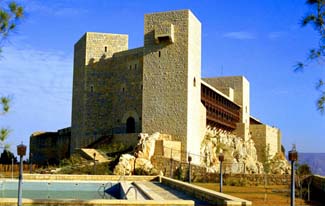
Photos courtesy of Parador de Jaén
Castillo de Santa Catalina s/n
23001 Jaén (Jaén)
Tel: ++34 953 23 00 00
Fax: ++34 953 23 09 30
Official parador website
Reserve with Booking.com
45 rooms
Double rooms: 100–225 euros
Single rooms: 80% of double
room rate
Rates include tax. Breakfast extra.
Free Wi-Fi
Open: all year
The parador is located 5 km west of the city of Jaén, which is off routes N-323 and A-316. Look up on the Cerro de Santa Catalina hill and you’ll see it. Jaén is served by train and bus.
On site: seasonal swimming
pool
Nearby: walks around Jaén;
Sierra Magina Nature Reserve;
hiking
When the Spanish government planned to install a parador at the Santa Catalina castle, they blasted the rock behind the actual Moorish castle in order not to damage the landmark silhouette and built a low-profile structure that wouldn’t be visible until the last moment while winding up the hill.
Constructed in local stone, it blends well with the original castle, and once you enter, you would never guess that you were not in an authentic medieval castle.
You approach the castle by winding up a circular mountain road and crossing over a drawbridge. Through the medieval gate and entry, you’ll find a three-story baronial hallway, with tapestries, baronial shields, and suits of armor, providing a medieval atmosphere.
Comfortable guest rooms feature canopied beds, fireplaces, and balconies that command views across the countryside dotted with olive trees to distant mountains.
The parador has a good reputation for its Andalucian cuisine, which is served in a Moorish-style dining room.
![]() Superb panoramic views
Superb panoramic views